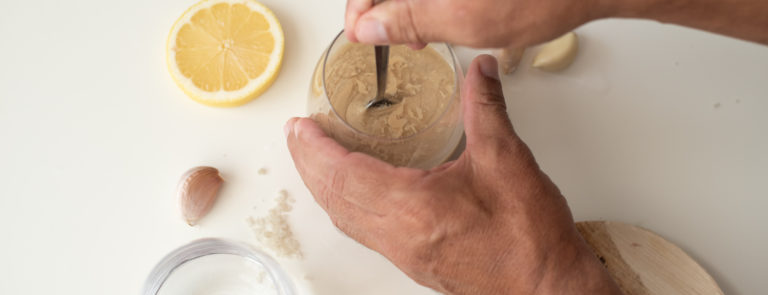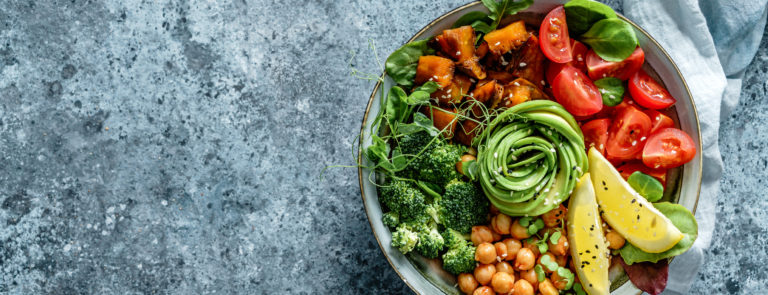20% off £30
Code:QUICK
How to make tahini

Make your own version of the multi-tasking sesame paste with our step-by-step guide on how to make tahini at home. Plus a tahini sauce recipe.
Adding a nutty depth, thickness and complexity to sauces, dips, marinades and even baked goods – tahini is a near-magical ingredient to have on hand in the kitchen.
Making your own tahini might seem like something you’d need to be an experienced cook to do. However, it’s surprisingly simple and rewarding and if you and your family eat tahini regularly, it could save you money, too.
Learn how to make tahini paste so good, you might never go back to shop bought.
What is tahini?
Tahini is a thick, creamy paste made from sesame seeds which have been toasted, ground and mixed with oil It’s been around for thousands of years, but tahini, also known as tahina, has only relatively recently become a staple in many UK kitchens. It’s sometimes marketed as ‘sesame butter’. Elsewhere in the world, especially in the Middle East, North Africa and Eastern Mediterranean, tahini is the foundation of many beloved dishes including hummus and baba ganoush. These cuisines also utilise sesame seeds in dips, sauces, for sprinkling over bread rings, pastries – both savoury and sweet – and used liberally in spice mixes such as za’atar. The sesame seeds used to make tahini are usually hulled, meaning that the outer layer or ‘husk’ has been removed. This is sometimes called ‘light’ tahini due to its pale hue. Light tahini has a mild taste. Sometimes, tahini is made from unhulled sesame seeds, which retain the husk and have a more bitter flavour. This is known as ‘dark’ tahini.Is tahini healthy?
It’s true that tahini is a calorie-dense food which can cause weight gain if eaten in too large quantities. With over 600 calories and almost 60g fat per 100g, you wouldn’t want to be eating tablespoons of the stuff every day. Luckily, tahini’s thick, oily texture means a little goes a long way. Tahini is a highly nutritious source of protein, fibre, calcium, magnesium, and unsaturated fat. It’s also a source of B-vitamins – which are responsible for energy production and normal brain function.1 Tahini also contains important trace minerals like selenium – an antioxidant which helps fight inflammation in the body – and copper – which helps the body absorb iron.2 Sesame seeds, tahini’s main component, have been liked to a reduction in oxidative stress in the body. Thanks to its impressive protein and fibre content, tahini can help keep you fuller for longer, making tahini a great weight-loss food despite its relatively high calorie count. So, tahini in moderation is a great addition to a balanced diet.Why make your own tahini?
Tahini from shops can be expensive. Not only will you save pennies making homemade tahini, you also have full control over the finished product and can be assured there are no unwanted additives or preservatives. You can play with the quantities until you find a tahini paste recipe which you really love.Tahini nutritional information
| 100g tahini | 1 x 15g tablespoon tahini | |
| Fat | 59.6g | 8.9g |
| Saturated fat | 8.5g | 1.3g |
| Calories | 631kcal | 94.6kcal |
| Sugar | 0.4g | 0.06g |
| Salt | 0g | 0g |
| Fibre | 8.1g | 1.2g |
| Protein | 18.7g | 2.8g |
Recipe for tahini
Find out how to make tahini below.Ingredients
- 150g hulled sesame seeds (use unhulled for a stronger, darker tahini)
- 3 tablespoons olive oil (or another light oil of your choice)
- Pinch of salt
Method
- In a large pan, toast the sesame seeds over a medium heat for around 3 minutes. Take them off the heat as soon as they take on a light brown colour. Be careful, they burn extremely quickly once they’ve gone brown.
- Spread the seeds out on a plate to stop the residual heat from the pan from over-cooking the seeds.
- Once cooled, blitz the toasted sesame seeds in a food processor until they are crumbly before adding the oil and blending until completely smooth. You might need to add a tiny drizzle of oil if the consistency isn’t quite there yet – you’re looking to be able to pour it smoothly. If you don’t have a food processor, you can make tahini paste using a pestle and mortar. It’s more labour-intensive but works well. Simply grind the cooled toasted sesame seeds in the pestle and mortar (you might need to do them in batches depending on the size of your pestle and mortar) until they’re soft and crumbly, then in a separate bowl beat in the oil and salt until smooth.
- Add salt to taste
How to make a tahini sauce
This recipe is so simple, but it transforms your raw tahini paste into a silky sauce. This method of preparing your tahini to make it the ideal consistency, strength and flavour to accompany a range of dishes including rice, fish, meat, flatbreads and more.Ingredients
- 1 clove garlic (or more to taste)
- 3 tablespoons tahini paste
- The juice of 1 lemon
- A splash of water
- A pinch of salt
Method
- Peel and grind the garlic along with the salt in a pestle and mortar and put to one side (you could also give it several passes in a garlic press – you’re aiming for a paste-like consistency).
- In a large bowl, beat the tahini with the lemon juice until the consistency is smooth. If the paste seems to thick, loosen with a little water.
- Add the garlic paste into the tahini and lemon mixture, beating until completely smooth. Spoon over flatbreads, shawarma, rice or baked fish.















